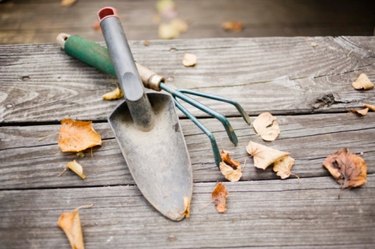Things You'll Need
Trowel
Clean paper
Plastic bag
Measuring cup
Shovel

A soil pH of 7.0 is considered neutral. Soils with a pH above 7.0 are alkaline while those with a pH below 7.0 are acidic. Most plants, ornamental grasses and vegetables grow best in soils with a pH around 6.0 to 6.8, although blueberries and rhododendrons need a pH between 5.0 and 5.5. When soils are too alkaline, plants may not be able to absorb nutrients, such as iron and magnesium. Plants often develop iron chlorosis, or yellow leaves, which can lead to defoliation and death. Aluminum sulfate, a granular fertilizer available at garden centers, instantly acidifies the soil while adding nitrogen.
Step 1
Remove small amounts of soil from several locations in your yard with a garden trowel. Mix the soil in a bucket, then spread it on clean paper to dry. When it is dry, return it to the bucket and mix it again. Scoop 1 cup of soil into a plastic bag or other sealable container and send it to a university extension office, a county extension office or a commercial lab for a soil test. Within a few weeks, you will receive an analysis that will detail your soil pH and offer recommendations for fertilizers.
Video of the Day
Step 2
Apply aluminum sulfate to the soil, according to package directions. Consider the current pH of the soil and the pH level you are trying to achieve. For example, if the current pH of your soil is 7.5 and you want to reduce it to 6.5, apply 1.2 lbs. aluminum sulfate for every 10 square feet of soil, advises Clemson University Cooperative Extension. Reduce the amount by one-third if you have sandy soils, and increase the rate by one-half if you have clay soils.
Step 3
Work the aluminum sulfate into the soil with a shovel and then water the soil thoroughly until it is evenly moist to activate the product. The aluminum in the soil raises the acidity instantly, while the sulfur breaks down more slowly, depending on the soil temperature and the bacteria in the soil. Sulfur breaks down most quickly in moist, warm soils.
Tip
Some extension offices offer kits that include the container or bag in which to send your soil and detailed directions on how to obtain the soil sample.
Reapply aluminum sulfate annually to your garden according to package directions to maintain the soil pH, and add nitrogen. Spread it on the soil and hoe it in gently around existing plants.
Mix sphagnum peat moss into the soil before planting a garden to improve drainage and add acidity to the soil.
Maintaining very acidic soil is challenging if you live in a dry, western area with naturally alkaline soils. If you wish to grow blueberries and azaleas, consider using an acidic potting mix in containers.
Warning
Aluminum sulfate can burn leaves or roots with which it comes into contact.
Video of the Day